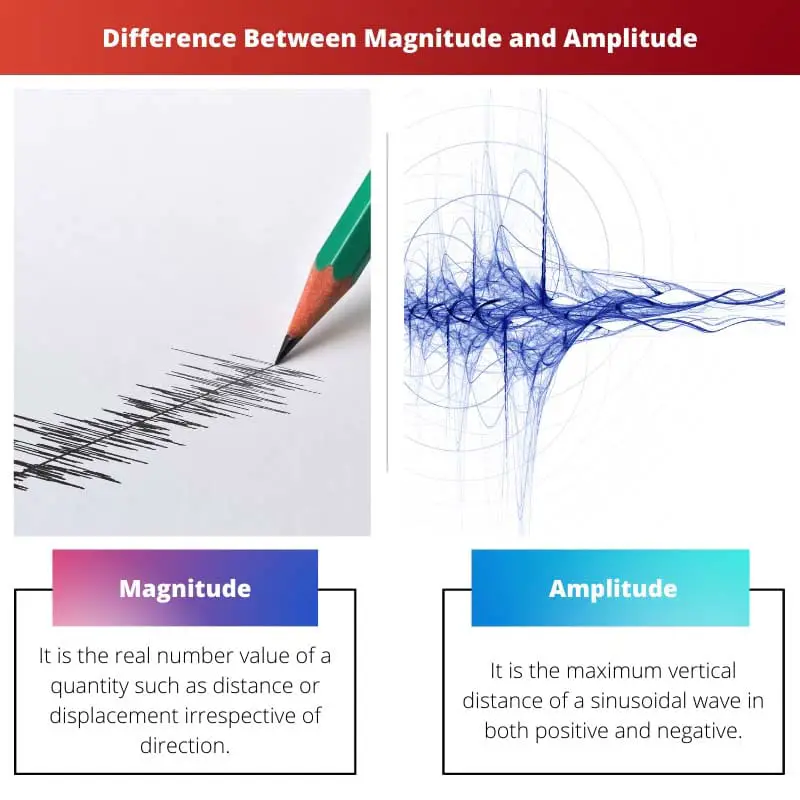Magnitude and amplitude are the terms representing some factors of important factors of science, more precisely, different branches of physics. In engineering, the differences are clearly understood by the students.
Magnitude and amplitude are different quantities and cannot be used interchangeably. So here are some basic differences between magnitude and amplitude.
Key Takeaways
- Magnitude refers to the overall size or amount of something, while amplitude refers to the maximum displacement of a wave from its resting position.
- Magnitude is a scalar quantity, while the amplitude is a vector quantity.
- Magnitude can describe various physical quantities such as force, energy, and velocity, while amplitude is used to describe properties of waves such as sound and light.
Magnitude vs Amplitude
The difference between magnitude and amplitude is that magnitude is used to define the real number or length of vectors in measurements of distances and other scalar quantities. Amplitude is mainly used in ac signals and oscillation theories. Amplitude is the measurement of the maximum vertical length of a wave on both positive and negative regions.

Magnitude is a factor used to determine a quantity’s value. Magnitude is a quantity used to measure a number’s real part. This is a factor in determining vector quantities.
Vector quantity comprises both the magnitude and direction of a factor to be determined. It can be both positive and negative.
Amplitude is used to measure the vertical length of a sinusoidal wave. It also measures the maximum and minimum values for a periodically changing quantity.
Amplitude is a scalar quantity, which means that it has only magnitude and so does not have any directions. Amplitude is a factor mainly used in ac signals, oscillation, and communication theories.
Comparison Table
| Parameters of Comparison | Magnitude | Amplitude |
|---|---|---|
| Definition | It is the real number value of a quantity such as distance or displacement irrespective of direction. | It is the maximum vertical distance of a sinusoidal wave in both positive and negative. |
| Properties of | It is a property of vector quantity. | It is a property that is unique to sinusoidal waves and oscillation. |
| Positive or negative | It can be both positive and negative. | It is always positive. |
| Used to measure | The real part of the value to a quantity. | The vertical length of a sinusoidal wave |
| Scalar or vector | It is itself a part of determining the scalar or vector quantities. | It is a scalar quantity. |
What is Magnitude?
Magnitude is a factor used to determine a quantity’s value. Magnitude is a quantity used to measure a number’s real part. This is a factor in determining vector quantities.
Vector quantity comprises both the magnitude and direction of a factor to be determined. It can be both positive and negative.
Magnitude is s common property of all the secondary quantities in physics. The secondary quantities are divided into scalar and vector quantities. If the quantity is scalar, that means that it poses only magnitude and no direction.
If the quantity is a vector, then it has both magnitude and direction. Magnitude is the size or the value of the quantity.
The magnitude can be measure by
a = √ (a12 +a22 +a32+…..an2)
Here ‘a’ is the total magnitude of the quantity.
For example, the distance and the displacement have the same meaning: the length between two points. But they differ as displacement is independent of direction, whereas distance has the factor of direction.
Displacement only has magnitude. The magnitude of a factor can be both positive and negative. A negative normally indicates that the magnitude is in the opposite direction.

What is Amplitude?
Amplitude is used to measure the vertical length of a sinusoidal wave. It also measures the maximum and minimum values for a periodically changing quantity.
Amplitude is a scalar quantity, which means that it has only magnitude, and so does not have any directions. Amplitude is a factor mainly used in ac signals, oscillation, and communication theories.
In communication engineering, the amplitude is one of the main factors in the field of communication. The whole process of signal transfer and modern communication is based on the amplitude of a signal wave.
The amplitude is varied accordingly to change the modulation of a wave and transmit the signal to the destination. There is a type of modulation known as amplitude modulation in which the amplitude is varied to change the modulation of a wave.
If we consider x as the periodically changing quantity with time t, then
x (t) = Asin2πft
Here, A is the amplitude of a wave.
The amplitude is independent of the factor direction. A wave’s amplitude can be measured on both positive and negative sides. But the magnitude of the amplitude of a wave is always a positive quantity. The amplitude of an ideal wave is the same on both sides of the number line.

Main Differences Between Magnitude and Amplitude
- Magnitude is the real number value of a quantity, such as distance or displacement, irrespective of direction. On the other hand, the amplitude is the maximum vertical distance of a sinusoidal wave in both positive and negative.
- Magnitude is a property of vector quantity; it is the main factor in determining the vector quantity of any factor. Amplitude is a property that is unique to sinusoidal waves and oscillation.
- Magnitude can be both positive and negative, but the factor amplitude is always positive.
- Magnitude is used to identify the real part of the value to a quantity, whereas amplitude is used to measure the vertical length of a wave.
- Magnitude is itself a part of determining the scalar or vector quantities. On the other hand, the amplitude is a scalar quantity.







